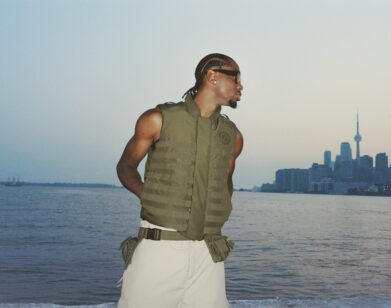Tokyo Drift
In 1981, Rei Kawakubo brought her label Comme des Garçons, already esteemed in Japan, from its home base in Tokyo to Paris for the runway shows. The next year, long before the conceptualist became an object of cult obsession, before John Waters devoted a chapter to her in his book Role Models (2010) and The New Yorker’s Judith Thurman reported that the austere, press-averse designer laughs at “people falling down,” Kawakubo debuted her seminal collection “Destroy,” a pitch-black battle cry of deconstructed shape and proportion. Skewered flippantly by critics as “Hiroshima chic,” it was an anathema to the louche, shoulder-padded glitz of the era’s other big guns—Mugler, Montana, and Versace. “The crows” (Kawakubo’s devotees, as dubbed by the press) considered it a clarion call to a new iconoclasm. But Kawakubo was not the last from Tokyo to send a rumbling sartorial upheaval through the couture capital: A new exhibition at the Denver Art Museum, “Shock Wave: Japanese Fashion Design, 1980s-1990s,” narrows in on the revolutionary aesthetic sensibilities of a generation of the Japanese avant-garde, including Kawakubo, Kenzo Takada, Issey Miyake, Yohji Yamamoto, Junya Watanabe, and Kansai Yamamoto, and their continuing influence.
Florence Müller, who joined the DAM last year from Paris where she worked as an independent curator and previously at the Louvre’s Musée des Arts Décoratifs, oversaw the exhibition. “It is the perfect time to devote an exhibition to the great Japanese fashion designers because they are so influential right now. You can observe the influence of their ideas and aesthetics in many trends, and especially among the young designers,” she notes. “Their impact has changed fashion with this notion of a non-seductive feminine representation and a woman who is dressed first for herself, and second, to express her strong personality. With this comes many things, such as the reign of asymmetry, the distortion in the cut of the garments, the all-black looks, the flat shoes, the no make-up, the ‘wired’ aspect of textiles and forms.”
Müller assembled 70 looks newly acquired by the DAM and loaned from LACMA, the De Young Museum, and private donors, including 10 ensembles from Joan Agajanian Quinn, a former west coast editor of Interview who regularly covered the shows in Paris and Tokyo. “Rei was very, very quiet and shy. I remember seeing her in her studio, looking at me from a crack in the door where she was designing. Her staff ate together at a big long table where she would sit quietly and on many occasions she invited me sit with them by motioning with her finger for me to join the group and sit next to her. Even though Rei was known as being a very strong force, she always stayed in the background,” Agajanian Quinn recollects. “Issey was more outgoing. He had spent time in France and the U.S., so he had more experiences with other of languages. We ate meals outside the studio with hand-chosen staff. Yohji was extremely quiet but totally friendly. He rummaged through the racks of the showroom pointing out his designs.”
In “Shock Wave,” Müller also juxtaposes the group’s influence on the next generation of designers, like Martin Margiela and Helmut Lang, and examines the tactics the designers used to recast tools of the industry—like advertising and store design—to their own sensibilities. “Suddenly, in a moment when the other designers were popular, treated by the magazines like rock stars, the Japanese, especially Rei Kawakubo, would refuse interviews,” Müller says. “They were inventing a new form of advertising, very subtle and non-commercial. Yohji Yamamoto would publish his seasonal ‘catalogs’ with photos by Nick Knight that looked like an art book. Kawakubo was publishing her catalogs like art magazines showing mostly artists. The boutiques looked like art galleries with rare garments ‘exhibited’ like unique art pieces.” Müller brings together some of the designer’s most iconic works—like Miyake’s molded torso bustier (Winter 1980-81), Comme des Garçons’s Quasimodo-like bump pieces (Spring/Summer 1997), and a graphic logo jacket from Kasai Yamamoto dating from the early ’80s. Per Agajanian Quinn, “The impact came by way of accessibility, openness and a breakaway from the system. Their radical styles were translated into simple lines and a more casual style by Parisian standards. It was a way to make things easier to wear as the public wanted comfortable and wearable clothes—a look that was easy.”
“SHOCK WAVE: JAPANESE FASHION DESIGN, 1980S-90S” IS ON VIEW THROUGH MAY 28, 2017 AT THE DENVER ART MUSEUM







